New products at Crocus
by Sarah - June 28th, 2009.Filed under: Crocus, New Products.
New items today at Crocus

broad-leaved bamboo £14.99
Position: full sun or to deep shadeSoil: tolerant of moist soils except dry soils if planting in full sunRate of growth: fast growingLeaves: mid-greenCanes: greenHardiness: fully hardyA vigorous medium-sized bamboo with green canes and mid-green leaves. This robust bamboo is best used as groundcover and for clipping into low moulds. It should only be introduced if you are prepared to keep it under control, since it can be extremely invasive and hard to eradicate once established. Garden care: Plant in a large container or surround the roots with a non-perishable barrier that restricts the plant's spread.
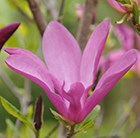
magnolia £14.99
Position: full sun or partial shadeSoil: moist, well-drained, acidic soilRate of growth: averageFlowering period: April to JuneHardiness: fully hardyA bushy, upright shrub with large mid-green leaves. From mid spring to midsummer, narrow goblet-shaped, fragrant flowers emerge from slender, dark burgundy buds. These open to slightly twisted petals which are burgundy on the outside and paler on the inside. A glorious deciduous magnolia that makes a lovely specimen for a small garden with acidic soil. Garden care: Requires minimal pruning. Remove any broken, diseased or crossing branches after flowering. Plant in a sheltered spot, adding plenty of peat to the planting hole. Mulch in spring with manure and leafmould, especially on dry soils.
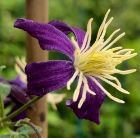
clematis (group 3) £9.99
Position: full sun or partial shadeSoil: fertile, well-drained soilRate of growth: fast-growingFlowering period: July – SeptFlower colour: rich purple flowers with pale yellow anthersOther features: easy to grow through shrubs and trees as the plant is pruned back each spring and so never becomes too much of a burden on the supporting plantHardiness: fully hardyRich purple star-shaped flowers with pale yellow anthers cover the plant from summer through to autumn. It looks great scrabbling through a tree or neighbouring shrub and in full sun the flowers have a stronger fragrance. Make sure that roots of the plant are in shade.Garden care: Cut back stems to a pair of strong buds 15-20cm (6-8in) above ground level before growth begins in early spring. Mulch in late winter with garden compost or well-rotted manure but avoid the immediate crown.
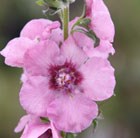
mullein £6.99
Position: full sunSoil: poor, well-drained, alkaline soilRate of growth: averageFlowering period: June to AugustHardiness: fully hardyDreamy spires of saucer-shaped deep rose-pink flowers from early to late summer above dark purplish-green leaves. This stunning rose-pink mullein is perfect for a sunny border or cottage garden. The vertical spires contrast well with the rounded flowerheads of pink peonies, such as Peonia lactiflora 'Madame Lemoine' or 'Sarah Bernhardt'.Garden care: Apply a 5-7cm (2-3in) mulch around the base of the plant in autumn to protect from winter extremes, taking care not to cover the crown. Stake in spring with bamboo canes or twiggy prunings before the flowers appear. Mullein moth caterpillars can be a problem, pick off the insects in early June as soon as they appear. Remove faded flower spikes.It is worth keeping in mind that these plants are mainly biennial, so although they usually self-seed freely, the plant will only live for two years.
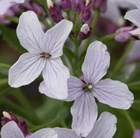
Perennial Honesty £6.99
Heart shaped leaves which can grow up to 8cm long, clothe the upright stems of this clump-forming perennial. These stems are topped by loose clusters of fragrant, lilac-white flowers in late spring and early summer. Once the flowers fade, they are followed by flat elliptical seed pods, which age to a beige colour that look like big, papery coins. If undisturbed, these will stay on the plant well into winter providing a long season of interest.Position: full sun or partial shadeSoil: fertile, moist but well-drained soilRate of growth: averageFlowering period: May and JuneFlower colour: lilac-whiteHardiness: fully hardyGarden care Easy to propagate from seed – just sow them in a seedbed in spring to produce new plants. Keep the soil damp until germination takes place. If the seedlings become over-crowded, thin out to 15cm (6in) apart. In autumn transplant the seedlings to their final flowering site 30cm (12in) apart.

Balkan cranesbill £5.99
Position: full sun or full shadeSoil: fertile, well-drained soilRate of growth: fast growingFlowering period: May to SeptemberHardiness: fully hardyClusters of small, saucer shaped, crimson-purple flowers are held on slender stems above strong aromatic, light green leaves from May to September. This is one of the most versatile and useful geraniums, as it will even thrive in dry shade. The deeply cut, semi-evergreen foliage also spreads quickly to form low hummocks that suppress weeds for most of the year. It looks lovely with strongly shaped perennials, such as bergenia, or polemonium, or planted en masse under trees, and is also valuable for hiding the foliage of spring bulbs as they die down. The leaves often turn red in autumn, too. Garden care: Carefully weed by hand – hoeing can break rhizomes as these are very close to the surface. Lift and divide large colonies in spring.

lungwort £5.99
Position: partial shadeSoil: humus-rich, moist, well-drained soilRate of growth: averageFlowering period: March to MayFlower colour: rich blueOther features: dark green leavesHardiness: fully hardyThis piercing blue cowslip bears clusters of rich-blue, funnel-shaped flowers from early to late spring and mid- to dark green leaves. Named after the woodland garden at Munstead Wood created by Edwardian plantswoman Gertrude Jeykll, it is a particularly lovely groundcover plant for moist, shady areas. Garden care: Lift and divide large clumps every three to five years after flowering or in autumn. Cut back plants affected by mildew to the ground, water and feed – the plant will regenerate and produce new leaves later in the year.
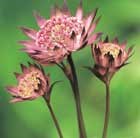
masterwort £5.99
Position: full sun or partial shadeSoil: fertile, moist, preferably humus-rich soilRate of growth: average to fast-growingFlowering period: June to AugustHardiness: fully hardyPapery, pinkish-magenta, pincushion-like flowers surrounded by a ruff of wine-tinted bracts are produced from June to August above deeply lobed, dark green leaves. Although it is an old cottage-garden favourite, this astrantia works equally well in contemporary-style plantings. Use towards the front of a sunny,yet moist border. Astrantias have been cultivated in Britain since the 16th century and have numerous common names, such as melancholy gentleman, Hatties pincushion and the more well known masterwort.Garden care: Astrantias do not like dry soil. Incorporate plenty of organic matter when planting and water well in dry weather especially newly established plants. Lift and divide large clumps in early spring and apply a generous 5-7 cm mulch of well-rotted manure or garden compost around the plant. Divided specimens may take some time to establish since they do not like having their roots disturbed.
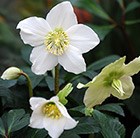
Christmas rose £5.99
Position: partial shadeSoil: heavy, neutral to alkaline soil including heavy soilRate of growth: average Flowering period: January to AprilHardiness: fully hardyDespite its evocative name, this lovely hellebore is rarely in flower by Christmas. But the white, bowl-shaped flowers are well worth waiting for, brightening up those dark winter days. The flowers appear on short stems, are sometimes flushed with pink, and unusually for hellebores, are usually upturned rather than nodding. They last for two to three months, and the handsome evergreen foliage is deeply cut and dark green. One of the earliest flowering plants, this is best planted in groups at the front of a partially shady mixed border, or beneath deciduous shrubs among spring-flowering bulbs. In former times, hellebores were planted close to cottage doors to prevent evil spirits from crossing the threshold.Garden care:A top tip from the Crocus crew is to cut back the old leaves down to the ground in January or February. This will show off the emerging flowers to best effect and it also helps to get rid of foliar diseases such as Hellebore leaf spot. Add lots of well-rotted leaf mould, compost or manure to the planting hole. Apply a generous 5-7cm (2-3 in) mulch of well-rotted organic matter around the base of the plant in autumn and providea top-dressing of general fertiliser each spring.






